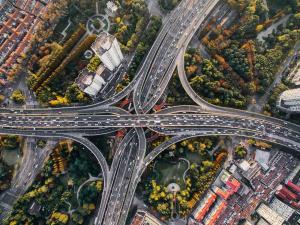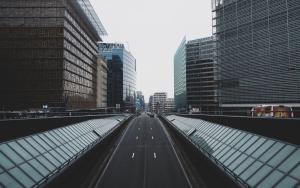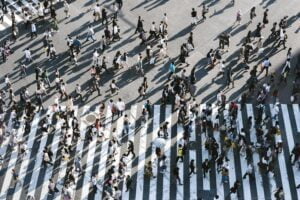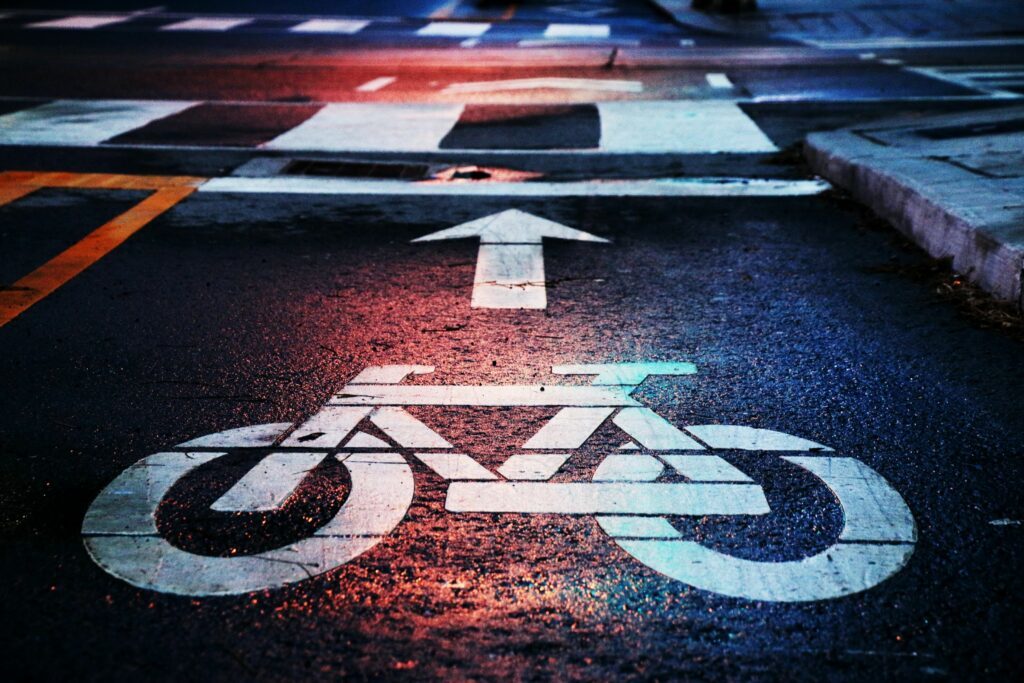Neglect and Survive: Mobility in Brussels
Dagmara Wrzesinska wonders if we are seeing a renaissance of mobility of Brussels… or should that be immobility?
Brussels: the economic, political and cultural centre of Europe. A house for many international institutions. A cosmopolitan, vibrant hub of diversity, innovation and growth fuelled by close to 200 nationalities for whom Brussels has become a home.
Brussels is a city that is, ultimately, car-centric for various reasons: a very particular tax structure that encourages companies to offer company cars as a benefit in kind with free fuel cards; a country-wide urban sprawl (nearly half of all employees working in Brussels commute to the city from neighbouring regions) combined with insufficient capacity of inter-regional public transport connections; or favourable parking rates for cars (yearly fees multiple times lower than a spot in a sheltered bicycle storage)(1)
Car-favouring culture has resulted in enormous congestion and has subsequently become a serious national issue. Costing up to 2% of the national GDP per annum, traffic jams are drawing on the Belgian economy to an extent so large that the OECD has been urging authorities to take actions against it (2). How did we end up here?
Philosophy of neglect or neglect of philosophy

The city from above
A miserable failure in urban planning in the past, or in other words Brusselization, allowed for the creation of a dense network of car parks, roads and tunnels enabling you to get very quickly from one side of the city to another. In theory, at least. Unfortunately, in practice it is consumed by eternally long traffic jams. Cars are an inherent part of the Brusselian reality, although approximately only half of Brussels inhabitants possess one.(3)
The resulting air pollution, jeopardised road safety, time loss due to congestion (an average Belgian loses over 7 days a year in traffic jams!(4) or damages to public health as a consequence of lack of psychical activity are only some of the disadvantages of excessive car use.
Providing a large share of the space for cars was achieved at the cost of surfaces for pedestrians and other transport modes and now it has suddenly become evident that even though cities are meant for people, not cars, Brussels has very little in common with human-centric design.
16th March 2020
Monday 16 March 2020, after confinement restrictions had been announced in Belgium, we all woke up to discover a new, intimidating reality. When the dust had settled, however, we realised that we were walking streets filled with people rather than cars. Due to the measures aiming to slow the spread of COVID-19, thousands of vehicles were grounded in parking lots.
Overnight, car-domination in Brussels had fallen. Soon after, we realised that space allocated to non-motorised traffic participants, which had shrunk in favour of cars for decades, resulted in an unexpected new type of congestion as sidewalks started to clog up. Rapid actions from authorities followed in order to increase available surfaces and allow for maintaining social distancing. Imposing new speed limits, roads closures, incredibly fast installation of new cycling paths and forbidding cars from entering the parks and forests, all have been warmly welcomed by citizens.
“We did not know how it would work out; it was a test. Soon we observed a much more harmonized situation and started to encourage other mayors in Brussels to try the same. The help that we offered was much appreciated, and we started a city-wide action to allow pedestrians and cyclist to benefit from all the space there is” said Marie Thibaut de Maisières, the spokesperson of the Mobility Minister of Brussels, Elke Van den Brandt.

Decades of neglect have forced authorities to act fast now.
The crisis induced by COVID-19 forced changes to our lifestyles, economies and environments. Yet our streets seem better than ever. A drastic 85% decline in the number of cars has contributed to a sudden drop in air and noise pollution. Most of all, cyclists and pedestrians have been picking up the slack and benefiting from the space they have never been granted. Are we observing a life-time chance to repair the damage done by a century-long car-focused urban design?
Unprecedented Challenges require Unprecedented Courage
Cities are heading in an unknown direction towards and uncertain future and that will certainly entail challenges that no one is ready for. By being smart Brussels now has the chance to not only recover from the crisis but to prosper mobility-wise. The undefined period, during which public transport cannot operate at full capacity, as well as a natural reluctance to crowds using public transport following the pandemic will require a very comprehensive problem-solving approach.
“Public transport operators have been doing a truly amazing job this whole time helping us to flatten the curve and maintaining the critical services in the city. However, even their greatest effort will not allow carrying all passengers when travel restrictions are being eased.” Could the increased share of cyclists and pedestrians in the modal split be the answer to that challenge? Alternatives are being provided to citizens, who are widely encouraged to benefit from the new opportunities: “the minister promised 40km of new cycling paths and has called everyone in good health to cycle and walk in order to reduce the occupancy of the public transport and to redistribute the demand for transportation in peak hours”.
While this will pose challenges in cities worldwide, in Brussels’ case, it is a particularly complex problem - “45% of public transport passengers in Belgium’s capital are being carried in just 4.5 hours of the day. This is uniquely short and represents an extremely heavy peak time window compared to other cities”– evaluates the cabinet of the Mobility Minister.
The Renaissance of Mobility

Walking streets fill with people rather than cars
Even though a mobility revolution started a while ago, together with growing access to data and tech-development, Brussels has never been able to seize its full potential. Despite all mistakes made in the past, the Belgian capital has still a great human-centric potential waiting to be seized.
Decades of neglect have forced authorities to act fast now. However, changes that are ongoing in Brussels - as much as they are done in the spirit of tactical urbanism - are not random. The Good Move plan has foreseen many fundamental changes in the infrastructure and space distribution to be implemented over the course of the next 10 years. The impact of the crisis on mobility has allowed an emergency-paced implementation of the plans which were there already. “Working in the spirit of tactical urbanism allows evaluating the actions that we take on a dynamic basis. We can see the places where new regulations are not working out and many places where it has a great potential to success. We can see neighbourhoods where after cars are gone, people are back,” says Marie Thibaut de Maisières.
It is no longer a question of if or when, but how. The crisis that we are experiencing has proven that we should not hesitate any longer. We have a range of tools in our hands to stop diminishing humans in favour of machines, which, for a while already, have been not only a mode of transport, but rather a social tribute and often a serious threat to our health and life.
The time has come to look around and take a minute to think of how we are going to fill these streets when we resume our lifestyles from before the pandemic. Will we have learned?
“We will surely keep some of the implemented changes, others will require further evaluation. It is crucial to ensure that we provide alternatives to cars. Car domination in Brussels is not something we are coming back to,” says the spokesperson of the minister.
Temporary changes to our lifestyles imposed by the crisis may evolve into an entirely new mobility culture, where (with a proper policy) a car is no longer the default option. As much as COVID-19 has disrupted our lives, it can also be a fast track to the future of mobility that is just around the corner. Creating a high quality and well thought-out network of cycling paths or encouraging employers to provide facilities that encourage and enable active travel to work will very quickly pay off in new numbers in the modal split. Paint is not an infrastructure and a small bicycle rack is not a facility: if we want to observe serious changes, we need to treat each other seriously.
To increase the safety of vulnerable road users, we need to increase drivers’ awareness and learn to be kind to each other. Paying more attention to what we teach our children, showing them good examples and exposing them to courtesy on the road will allow us to raise a generation for whom walking and cycling will be natural choices. We all need to learn how to share the roads. Neither Amsterdam nor Copenhagen woke up one morning and discovered that they were the cycling capitals of Europe. It takes generations to create a culture. Brussels does not belong only to cars, but to all road users. Thus, while creating the future, let us not forget universal accessibility.
Considering how our lives have been disrupted, the occasion to start establishing a new normal in Brusselian mobility has never been better. People have already started taking back the streets. From now on, let’s put humans first.
Additional information:
Brussels Capital Region was chosen as the winner of the 8th Award for Sustainable Urban Mobility Planning (SUMP Award), that focused on safe walking and cycling.
With GoodMove, Brussels Capital Region has set itself clear and ambitious sustainable mobility goals, which include having zero road traffic deaths by 2030, restricting car usage, reducing the speed limit to 30 kilometres per hour by 2021, and increasing the number of pedestrianised zones.
The jury of the SUMP Award was particularly impressed by Brussels’ approach to reaching these goals. The city’s achievements are underpinned by strong stakeholder outreach, impressive citizen participation, and the implementation of “superblocks”, an innovative urban planning concept.
Author: Dagmara Wrzesinska is project manager: Mobility at the Vias Institute in Brussels. Contact via email dagmara.wrzesinska@vias.ve
References:
1. https://journals.openedition.org/brussels/1680 2. https://read.oecd-ilibrary.org/economics/oecd-economic-surveys-belgium-2013/better-use-of-infrastructures-to-reduce-environmental-and-congestion- costs_eco_surveys-bel-2013-5-en#page2 3. https://newmobility.news/wp-content/uploads/2018/10/download-clip_20181031_le-soir-magazine_p-32-33.pdf 4. https://www.tomtom.com/en_gb/traffic-index/brussels-traffic/
 Brussels
Brussels